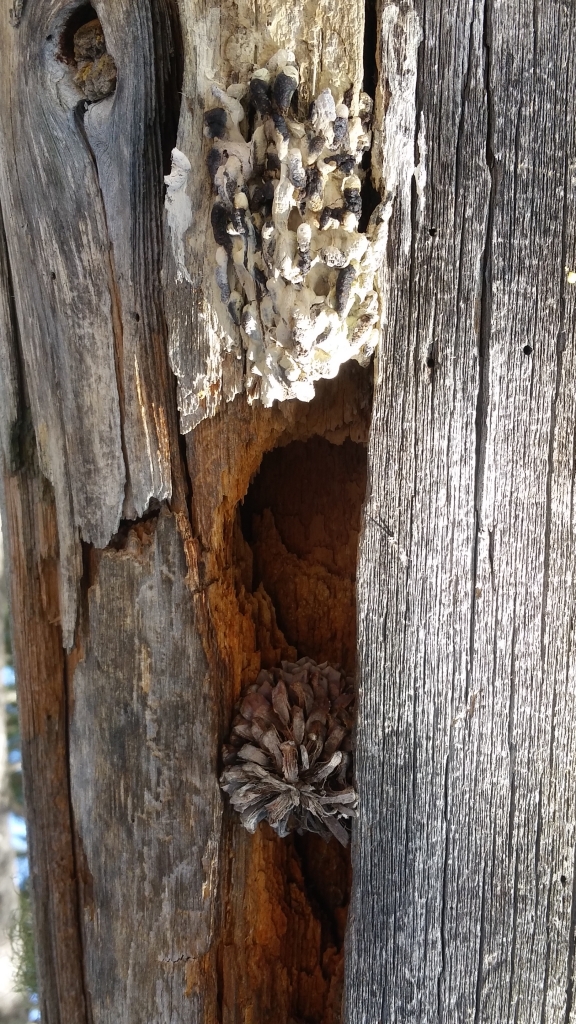By Ian Pendry, UIMLA International Mountain Leader
Have you ever been strolling through the forest in the winter and wondered why you suddenly see a scattering of pinecones around the base of a tree, or even better seen a pinecone that looks to be wedged into a crevice in the tree? Well, wonder no further. The culprit is one of my favourite birds: the woodpecker.
Here in the Pyrenees Orientales we have a number of the woodpecker family, the Green Woodpecker, the Lesser Spotted Woodpecker, the Greater Spotted Woodpecker and the Black Woodpecker.
Green Woodpecker

The Green Woodpecker is easy to identify by its green colouring and the classic woodpecker red stripe, or crest, above its eyes.
You generally spot the Green Woodpeckers on the edges of forested terrain because it feeds mainly on bugs and grubs found in the grassland surrounding the forests. If you have ever spotted anthills with round holes dug into them then this is a favourite feeding style of Green Woodpeckers.
We often hear Green Woodpeckers before we see them as they have a distinctive cackling, or laughing, style of call: “he he he he he he”.
They are easy to spot in flight because of their distinctive flight style, which all woodpeckers have. It is best described as undulating with bursts of wing beats at the bottom of each undulation to gain height before the next roll (see below).
Green Woodpeckers do make holes in trees to nest in, as with all the woodpeckers, but are the least prodigious hole makers. It is roughly possible to tell which woodpecker has made which hole by the size of the hole (see below).
Lesser Spotted Woodpecker

Lesser spotted because it is the smallest of the spotted woodpecker family (15cm tall). It is easy to tell apart from its cousin the Greater Spotted Woodpecker as the Lesser Spotted Woodpecker is mainly black and white (spots & stripes or Pied), but still has the distinctive red flash on its head.
When you walk in the forest and hear a distinctive “Tchik” or “Pee pee pee pee pee “ call, this is the Lesser Spotted Woodpecker. The Lesser Spotted Woodpecker is also mainly an insect feeder and will hop around the trunks of the pine trees searching for insects in and under the bark with its powerful beak.
Greater Spotted Woodpecker

Larger (23cm tall) than the Lesser Spotted Woodpecker the Greater Spotted Woodpecker is easy to spot by its distinctive red trousers in addition to the red flash on its head.
Its call is similar to that of its cousin, but more assertive with an explosive “Tchik”.
The Greater Spotted Woodpecker feeds on insects, like all of the species, but is also a prodigious nut and seed eater.
The woodpecker anvils (see photos below) that we find carved into trees are generally from the Greater Spotted Woodpecker. We often find these with both pinecones and hazelnuts wedged in. This method allows the woodpecker to hammer into the pinecone or nut to extract the seeds. Intelligent eh?!
The result of this activity is the pile of hammered looking pinecones we see around the foot of the tree. Look up and you will find the anvil. Another clever trick of the woodpecker is to hammer into the bark of living pine trees. The reaction of the tree is to release sap to protect the interior of the tree. All kinds of flies and bugs are attracted to this sap as a source of sugary energy, however the unwary are often trapped in its stickiness. We call this a Woodpecker Larder and it can be seen in the form of round weeping wounds or horizontal rings in the tree bark (see photo).
The woodpecker does a regular tour of these sites to feed on both the trapped bugs and the sap itself.
Black Woodpecker

The Black Woodpecker is the largest of the woodpeckers (45cm tall) and also the shyest. Often hard to spot, it is easier to hear with very loud machine gun speed drumming and a loud plaintive “Pyuuuu” call.
If you get a chance to spot one, you will discover a large crow or jackdaw sized bird, but with the traditional woodpecker shape and an all-black plumage with the classic red flash on its head.
The feeding signs of Black Woodpeckers are pretty easy to spot. It is definitely the most destructive of the woodpeckers; completely destroying rotten trees in its search for grubs and larvae and often causing the standing dead trees to fall.
Where to spot them…
In the tree
In the air

How do they do that hammering without getting a headache?
All that hammering and head banging must hurt eh?! Well, not for a woodpecker. The beak is incredibly powerful and the brain is protected from the impacts (which would otherwise cause significant damage!) by being suspended in a special soft bony structure, which disperses the shocks. In addition to this, the tongue of the woodpecker wraps all the way to the back of the skull, providing essential cushioning and extra stability.

So next time you are strolling near or through the forests of the region look out for the calls and signs of this amazing family of birds.
Enjoy your walks and more next week….
FIND OUT MORE ABOUT IAN AND THE MOULI DEL RIU CHAMBRES & TABLE D’HÔTE AT SAINT PIERRE DELS FORCATS
Missed the last post? Catch uP HERE







What beautiful birds, especially the greater woodpecker caught my attention
Fascinating! I have sometimes seen the first three species around St Pierre and knew they hid their food in tree trunks, but didn’t realise they did it differently. Thank you for all ths extra information!